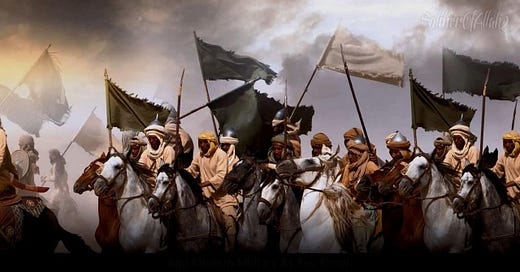In an era marked by geopolitical upheaval, moral decay, and existential anxieties, Islamic eschatology offers a lens through which Muslims interpret the chaos of the modern world. The prophecies about the end of times—Akhir al-Zaman—resonate deeply today, as conflicts, environmental crises, and ideological battles mirror the signs foretold in Islamic tradition. Central to these prophecies is the notion of a cyclical struggle: the decline of the Muslim world, followed by its resurgence from the region of Khorasan, symbolized by an army carrying black flags. This article explores these prophecies in detail, linking their ancient wisdom to contemporary realities and the spiritual resilience they inspire.
The Historical and Spiritual Significance of Khorasan
Khorasan, derived from the Persian Khor (sun) and asan (rising), once spanned vast territories in Central Asia, including parts of modern-day Iran, Afghanistan, Turkmenistan, and Pakistan. Historically, it was a cradle of Islamic scholarship, trade, and military power. Cities like Nishapur, Merv, and Herat produced luminaries such as Imam al-Bukhari (compiler of Hadith) and the philosopher Al-Ghazali.
Why Khorasan?
Islamic tradition highlights Khorasan as a spiritual and strategic epicenter. The Prophet Muhammad ♾ reportedly said:
"A group of people will emerge from the East [Khorasan]; they will pave the way for the Mahdi’s rule." (Ibn Majah)
This prophecy is rooted in the region’s historical role as a frontier of Islamic expansion and resistance. During the Abbasid Revolution (8th century), black banners from Khorasan symbolized the overthrow of the corrupt Umayyad Caliphate, a prelude to how later generations interpret the “black flags” of eschatology.
The Prophecies: Decline, Black Flags, and the Mahdi
1. The Decline of the Muslim World
The Quran and Hadith warn that internal corruption—not external enemies—will erode the Muslim world’s strength. Allah says:
"Corruption has appeared throughout the land and sea by [reason of] what the hands of people have earned..." (Quran 30:41).
Modern Parallels
Today, many Muslim-majority nations grapple with:
Authoritarian Regimes: Governments prioritizing power over justice.
Sectarian Divisions: Sunni-Shia rivalries fueling violence (e.g., Yemen, Syria).
Moral Erosion: Consumerism and secularism overshadowing Islamic values.
Foreign Domination: Neo-colonial exploitation of resources (e.g., oil, minerals).
This decline mirrors the prophetic warnings of a time when "the best of your wealth will be the sheep you graze on mountaintops, fleeing from tribulations" (Hadith, Al-Hakim).
2. The Black Flags of Khorasan
A famous Hadith states:
"If you see the black banners coming from Khorasan, join them, for the Mahdi will be among them." (Ibn Majah)
Symbolism of the Black Flags
Justice vs. Oppression: Black flags historically symbolized revolt against tyranny.
Renewal of Faith: The army is described as "people whose hearts are like blocks of iron"—unyielding in their devotion.
Modern Misinterpretations and Realities
Groups like ISIS co-opted black flags, distorting the prophecy to justify terrorism. However, scholars emphasize that the true army from Khorasan will:
Reject extremism.
Unite Muslims under justice, not violence.
Be led by the Mahdi, a figure chosen by Allah, not self-proclaimed leaders.
Geopolitical Connections
The modern “Khorasan” region remains volatile:
Afghanistan’s Taliban resurgence (though their legitimacy is debated).
Resistance movements in Iran and Central Asia against authoritarianism.
Grassroots Islamic revivalism among youth disenchanted with materialism.
3. The Mahdi: The Guided Reformer
The Mahdi (Arabic: the rightly guided one) is prophesied to emerge during a period of chaos. He will:
Be a descendant of the Prophet Muhammad ♾.
Fill the Earth with justice after it was filled with oppression.
Unite the Muslim world and prepare it for the return of Jesus (Isa).
The Mahdi in a Modern Context
While some await a literal figure, others interpret the Mahdi as a metaphor for collective revival. For instance:
Social media campaigns for justice.
Movements combating Islamophobia and promoting interfaith dialogue.
Charitable organizations addressing poverty and climate crises.
4. The Return of Jesus (Isa) and the Defeat of Dajjal
Jesus (Isa) is revered in Islam as a prophet who will return to:
Break the cross (symbolizing the rejection of false dogma).
Kill Dajjal (the Antichrist), a figure embodying deception and materialism.
Establish global peace.
Dajjal’s Modern Manifestations
Surveillance Capitalism: Tech giants monopolizing data.
AI and Deepfakes: Tools for mass manipulation.
Materialism: A world where "success" is measured by wealth, not morality.
Lessons for Contemporary Muslims
Moral Vigilance: Combat corruption and greed.
Unity Over Division: Reject sectarianism and nationalism.
Resilience: Stay steadfast in faith despite trials.
Critical Thinking: Avoid alarmist interpretations of prophecy.
Cautions Against Misinterpretation
ISIS: Distorted eschatology to justify atrocities.
Cults: False claimants of Mahdi status.
Political Manipulation: Autocrats using eschatology for control.
Conclusion
The Khorasan prophecy is ultimately a narrative of hope. It assures Muslims that no matter how fractured the world becomes, divine justice will prevail. As the Quran reminds:
"Allah will not change the condition of a people until they change what is in themselves" (Quran 13:11).
The “black flags” are not just an army, they symbolize the unwavering faith and moral courage required to illuminate a darkened world.






